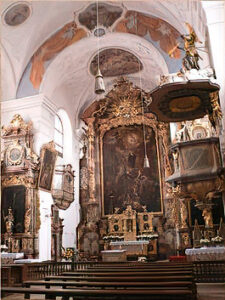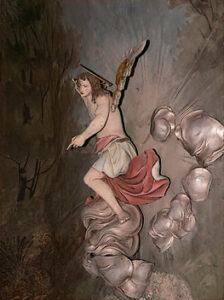Anyone attending a Catholic liturgy for the first time is struck by the number of gestures, images, and items of clothing that one just never sees anywhere else.
Some of the leaders might be resplendent in silks with gold embroidery – straight out of a painting by Benozzo Gozzoli who lived between 1421-1497.
In some places you will hear bits in Latin in a 19th century makeover of a late 8th century pronunciation system – itself invented because people north of the Alps could no longer understand people from south of the Alps. It was out of date as a medium of everyday communication even then!
You might hear bits of this sung in so-called Gregorian chant: a modern choir trying to reproduce an early 20th century reconstruction of what a medieval monastery in France might have sounded like.
Then there are gestures – bowing and even genuflections – that are derived from the hierarchical world of the Byzantine imperial court but now used by people who claim that they embrace human equality and democracy.
An ancient chapel
A while ago I visited a museum/art gallery that was located in a former palace. I found that one of the rooms on the itinerary was what used to be the chapel.
Indeed, it still was the chapel except that it had not been used for worship for several decades.
It had, however, still been a chapel around 1970 for someone had added a “new altar” that was free-standing. But now that addition was just one more architectural/cultural exhibit.
I stood there for quite a while – maybe 20 minutes – and observed the reactions of people who entered. It was so much part of the historical fabric of the palace that no one noticed that it was actually a chapel very similar to many small parish churches in that region.
It was a place to admire baroque decoration rather than to pray.

Let us marvel at the work of human genius. But is this a place to visit and admire or one intended for the disciples of Jesus to gather for the Lord’s Supper?
The past is perfect
Unfortunately, much of our liturgy may seem attractive, not because it speaks to us of God, but because it pleases our sense of order and beauty.
But we assemble liturgically to be prophetic and to empower our discipleship, not to have an aesthetic experience.
Two dangers linger on the edges of Catholic worship – and indeed on that of all those churches which have a liturgy inherited from the past;
First, we confuse the sacred with the solemn.
The sacred makes us aware of something beyond, the mystery that is greater than life.
The solemn merely makes us aware of the “big” and the “powerful”.
Second, we confuse the numinous with the aesthetic.
The numinous is the awareness that life is not self-explanatory and that we are drawn outward by the Other. It is the sense that Moses is on “holy ground” (Ex 3, 5).
The aesthetic is located within our universe and rejoiced in what pleases us and our individual sense of “beauty”.
In an ideal world, there might be no distinctions between the sacred and the solemn, the holy and the beautiful. But given that human beings vary, we have to be careful that a human sense of pomp and circumstance does not drown out the whispering voice of the Spirit.
The past is past
But some will cry: we have to have the past! Change is impossible!
This is a frequent human response to religion and we conflate faith with a warm sense of pious nostalgia.
We add to this confusion when someone points out that a prayer in Latin “goes back to the time of St Gregory the Great!” in the 500s. Then they insist on translating it so that one has a sense that the original Latin is elegant, rather than in a manner in which it can be easily understood.
But much of this nostalgia merely tells us that the style is old, not that it is holy.
The voice of God speaks to us today in our world, just as his creative love is what upholds us in existence right now.
Our God is the god of the living and of hope for tomorrow.
The category of “the silly”
But do we not need museums and can we not be nostalgic?
Yes. Have as many museums as you want and visit them. You can even choose to live close to one and spend time in it every day!
But (1) do not confuse a museum with worship. And remember that (2) many people hate museums – or think of them as places where you see what is silly and out of date.

‘The problem with museums is that all the stuff is out of date!’ – an 18-year old student.
Also, be careful!
I know lots of clergy who love visiting museums: museums seem to be their sort of place. But museums are a minority taste!
Ask any parent thinking of “days out” with their kids: they will tell you that a little bit of a museum goes an awfully long way.
Some months ago, a mother was having a conversation with her daughter about the daughter’s reasons for not “going to Mass”.
“But Mum,” she said, “the clothes the priest wears are just silly.”
If our reaction to anything in the liturgy is that it’s “just silly”, then that will not make it a good basis for the worship of God.
- Thomas O’Loughlin is a presbyter of the Catholic Diocese of Arundel and Brighton and professor-emeritus of historical theology at the University of Nottingham (UK). His latest book is Eating Together, Becoming One: Taking Up Pope Francis’s Call to Theologians (Liturgical Press, 2019).
News category: Analysis and Comment, Palmerston.




